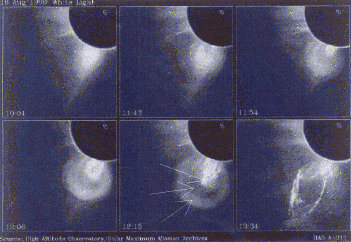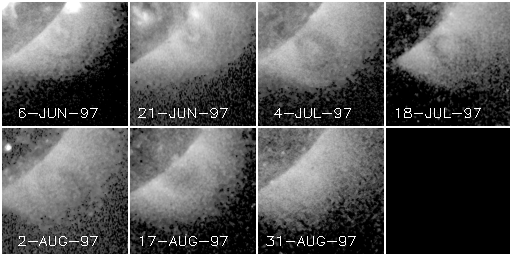
Again an apology - all you tenors, altos, basses, sopranos, baritones and so forth: this science nugget has nothing to do with music theory. Instead we point out some nice features of coronal mass ejections (CMEs), which are among the most spectacular and beautiful of the solar observations. They often tend towards a three-part morphology, as shown below:

Click on the figure to enlarge it; this is a highly converted figure
of great historical value, showing a CME observed by the Solar Maximum
Mission on August 18, 1980.
The arrows show the three parts of a three-part CME
quite clearly: the front, the cavity, and the core (bottom to top).
Although controversy still rages, lo these decades later, regarding the
physical interpretation of the front and the cavity, all workers agree
on the identification of the core as the coronal counterpart of an
erupting filament.
These filaments are also beautiful creatures even when they're passive
and not erupting!
In ways that we do not understand, these three parts of a CME contribute
to the global physics that underlies the event, and research continues,
for example in the directions described below.
What's new with the 3 parts
We have three new things to show the world here. Two of them relate to 3-part structure seen in soft X-rays, and one of them shows 3-part structure in meter waves. These are all entirely different views of a CME, since the coronagraph shows us every bit of mass in the corona, whereas the soft X-rays show only the hottest parts. At meter waves, we see only non-thermal particles, we believe - not coronal gas at all in the strict sense. But first a preview: [1] [2] previous nuggets showed us this sort of soft X-ray structure:

This set of pictures looks for all the world like a 3-part coronal mass ejection, but check out the times of the images: this was a quiescent structure, not an eruptive one. From this we suspect that 3-part harmony in coronal physics goes a bit deeper than the eruptions alone. Now for some new stuff - it just gets more and more interesting:
Conclusion
So there you have it: progress on all fronts, which we think shows that the 3-part structure not only forms a basic building block of eruptions, but also of the quiet corona; we also are surprised to find that non-thermal particle acceleration can pervade the three parts. Again we are left with the curious coronal mixture of MHD structures intimately (inextricably?) involved with plasma processes. No wonder the theory is so hard!